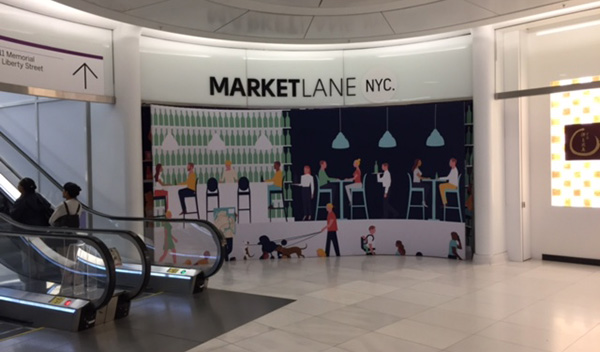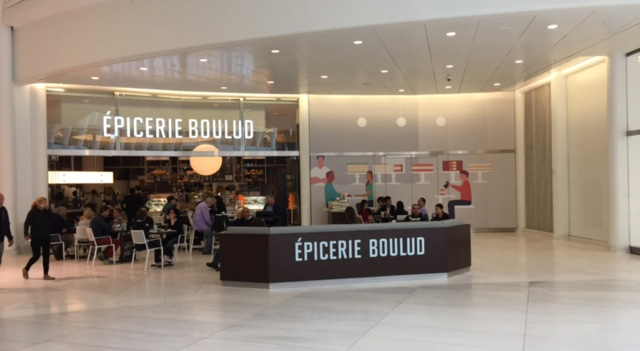Over the Memorial Day weekend, the World Trade Center mall buzzed with tourists who crowded its stairs and peered up from the floor of the main hall to gaze upon Santiago Calatrava’s marble Oculus.
But nearly a year after Westfield Corp. unveiled the long-delayed first phase of its $1.5 billion shopping complex, the World Trade Center mall remains littered with vacant storefronts.
While Westfield announced that the entire 290,000 square feet of Phase 1 had been leased when the mall opened in August, roughly 20 percent of the space remains empty and unopened, according to calculations by The Real Deal. A spokesperson for the company declined to comment.
Many storefronts are covered over with wrappers directing shoppers out of the underground portion of the mall and up to the Eataly market on the third floor of Silverstein Properties’ 4 World Trade Center. And as Westfield works alongside Silverstein on the second, 75,000-square-foot Phase 2 in the base of 3 World Trade Center – expected to be completed in 2018 or 2019 – the Australian-based mall REIT is rushing to get delayed stores open and is trying to correct the perception of the project as a transit hub and a retail afterthought.

Signs covering vacant storefronts direct shoppers outside the main section of the mall toward Eataly. (credit: Rich Bockmann)
Industry insiders are watching the project closely, and while opinions are mixed, consensus is it hasn’t gotten off to a smooth start. One retail expert called it a “disaster” with all but a few standout stores reporting poor sales. Others, however, said any mall operator takes a while to figure out the right mix of retailers, and had confidence that Westfield will right the ship in the long term.
“There are always a few breakout stars, and there’s always a little bit of an adjustment just to get the mix right,” said Lisa Rosenthal of Eastern Consolidated. Rosenthal added that both the original World Trade Center mall and the Time Warner Center tried out different tactics following slow starts.
“Sometimes it takes two iterations to get it right,” she said.
In the meantime, Westfield continues to declare that its Lower Manhattan mall will be one of the most successful in the country. In its annual earnings presentation in February, the company said it expects the mall to notch $1 billion in sales per year, assuming 3 percent organic growth through 2020. That would work out to roughly $2,740 per square foot, which would make the WTC mall the second-most profitable mall in the country behind the luxury Bal Harbour Shops outside Miami, which recorded sales of $3,185 per square foot, according to a May 2016 CNBC report that cited data from REIT research firm Green Street Advisors.
Green Street ascribed an A+ rating to the WTC mall project, and while the company declined to provide specific per-square-foot figures, a spokesperson said the number “is much lower” than the $2,740 per square foot figure Westfield has projected.
Wide open spaces
Westfield’s leaders have been tight-lipped when it comes to specifics on the project, both in public and behind closed doors. During the company’s annual shareholders meeting in April, co-president Peter Lowy made only a brief mention of the mall as he wrapped up reporting 2016’s results.
“During the year, we successfully opened the $1.2 billion major stage of Westfield World Trade Center ahead of our target yield,” he said, referring to the yield-on-cost of roughly 6.5 percent the company expected to earn during the construction stage of the project. Behind the scenes, retail brokers said Westfield was playing the development close to the vest, revealing little about how the mall is operating.
But while Westfield remains bullish, major portions of the project remain unopened. It’s especially noticeable along the western concourse, the long hallway that connects the Oculus’ main hall underground to Brookfield Property Partners’ Brookfield Place.
The hallway resembles an airport concourse sans the moving sidewalk, with one side covered by video display boards and the other side dotted with open shops that show little activity. Few passersby seem interested in stopping to shop as they travel from one end to the other.
It doesn’t help that when shoppers enter the concourse from the main hall, the first thing they see is a row of empty storefronts: the first five shops – or nearly 140 feet of frontage – remain boarded up behind window wrap and construction signs. The same is true on the western concourse’s second level, though the mall’s directory indicates that a large Duane Reade pharmacy is set to open soon. That store, which early presentation materials had indicated would measure more than 6,000 square feet, is one of two large shops that has yet to open.
The other is a 10,000-square-foot Market Lane grocery store (formerly known as Jones the Grocer) that has yet to open at the far end of the upper level of the southern concourse, which brings shoppers from the main hall toward 4 World Trade Center. With the store still unopened, the mall is lacking a key anchor that can draw shoppers from one side of the concourse to the other.
Michael Goldban, the senior vice president of retail leasing at Brookfield Property Partners, said he thinks the Westfield project will be a success once all the shops are up and running, particularly the stores with more challenging buildouts.
“A larger store is a lot more complicated than a smaller one, especially something like a grocer or a drugstore,” he said.
But it’s not just construction delays that are keeping shops empty. On the southern concourse’s lower level, there are four empty storefronts where tenants had refused to take possession of their spaces before the mall opened last year, claiming they weren’t in tenant-ready condition when Westfield delivered them after more than a year of delays due to construction by the Port Authority of New York and New Jersey.
Westfield sued those tenants for breach of contract and court records show that one case — against fashion retailer True Religion — was discontinued in September. A source said that another lawsuit against women’s fashion retailer Bebe has been settled. Signs on the Bebe space show that a Starbucks coffee shop is set to open there.
The Bebe case highlights the crucial problem that empty stores pose for Westfield. The lease Westfield attached in its lawsuit against Bebe shows the two sides had negotiated a co-tenancy clause that said if a certain square footage in the project remained empty when the mall opened, Bebe would pay a percentage of gross sales in rent, instead of its base rent and percentage rent. The figures on square footage and the percentage of sales were redacted from court documents, but sources said other tenants are likely to have similar clauses – based on how much leverage they brought to the negotiating table when hammering out their leases. Sources also said that triggering co-tenancy clauses can place a major financial strain on a project, possibly even leading to default.
A source familiar with another legal case said that since the retailer signed its lease through an LLC, all Westfield could hope to gain through litigation is to recoup the tenant’s $300,000 security deposit. The source said that the landlord was aggressively litigating cases in order to set a precedent.
Sholto Maconochie, an analyst for CLSA in Australia who covers Westfield, said every mall operator has to deal with unexpected contingencies when a new mall opens. He believes there’s still strong demand from retailers who see the WTC mall as a destination.
“A new or heavily redeveloped centre can take up to 2 years to fully stabilize,” he wrote in an email to TRD. “I think it may take longer to stabilise than other centres, but on a 3-year view should be fine.”
Signs of the times
For Westfield to hit its aggressive targets, it will also need to resolve a series of other challenges.
The company is battling the Port Authority and Silverstein in court over the signage it can place around the World Trade Center campus. In May, Westfield asked a judge to step in after Silverstein filed a notice with the Port Authority seeking arbitration to remove the mall landlord’s signs. The court case — which involves not just signage but also “mall-type retail kiosks” on the main hall’s Ground Floor And On The Street level around the Oculus — is still ongoing.
And there appear to still be issues with the $4 billion Oculus that suffered from construction delays. Construction and maintenance workers last week reportedly said that the transit hub continues to leak after heavy rains, causing puddles and slip-and-fall accidents on the floor.
Westfield will also have to overcome an industry-wide downturn in the retail sector, one that has hit mall operators hard. Nowhere is that challenge more evident than the empty space directly in front of the Apple store on the ground level of the main hallway. The space, located in the priciest part of the mall, had previously been leased to Michael Kors. But the struggling fashion retailer never moved in, and last week the company announced plans to shutter 100 or more stores over the next two years.
Even before the mall landlord opened the first phase, there were critics who said the overall project was designed primarily as a transit hub with the shopping aspect as an afterthought. Skeptics said that retailers wouldn’t want to be underground, and questioned the likelihood that commuters would be interested in shopping at high-end luxury shops after getting off the train.
It should be noted, too, that due to construction delays the mall is opening later in the economic cycle than Westfield had originally hoped. The city is expecting foreign tourism to decline this year for the first time since 2008.
After Westfield completes the $300 million Phase 2 of the mall, it will have another 90,000-square-foot phase at 2 World Trade Center, which has yet to find an anchor tenant that allows Silverstein to start construction.
One retail broker, who spoke on the condition of anonymity, said it’s hard to pinpoint which aspects of the mall are struggling due to broader factors facing the retail sector and ones specific to the project’s design – or how Westfield can fix them.
“It’s a little bit of both. We’re obviously seeing a revolution – a major change – in how people operate,” the broker said. “And this is supposedly the good part of the economic cycle.”


